CGKB News and events Conservation - Cultivated Rice
Sample processing in seed banks of cultivated rice genetic resources
Contributors to this page: T.T. Chang Genetic Resources Centre-IRRI, Los Baños, Philippines (Ruaraidh Sackville Hamilton, Ken McNally, Flora de Guzman, Renato Reaño, Soccie Almazan, Adelaida Alcantara, Elizabeth Naredo); WARDA, Cotonou, Benin (Ines Sánchez); UPLB-University of the Philippines at Los Baños (Teresita Borromeo).
|
Contents: |
|
|
Cleaning is the removal of physical contamination from the plant material after harvest, before it can be stored. The exposure to unfavourable conditions should be minimized for greater seed longevity in storage.
- Immediately after harvesting, thresh and blow the seeds and place them in the drying room within the day (see details below).
- Pre-clean the dried seeds by blowing to separate unfilled grains and low density materials.
- Manually clean the seeds.
Visual inspection of seeds
- Verify the sample by comparing it with the seed file.
- Determine the selection to be carried out based on the recommendation during the verification process.
- Examine the seeds and hand sieve them with graded mesh sizes (if mixtures/off-types vary in size) to separate slender and bold grains (manual cleaning limits contamination and damage especially when the seeds are very dry).
- Remove discolored, deformed, infected, soiled, immature, damaged, germinated seeds and off-types.
- Determine the actual action to be taken based on the quantity of clean seed (this will determine the packing system to use).
- Prepare and label all the necessary envelopes for use in seed testing, viability testing and for storage in the base, active and temporary storage.
- Submit the selected samples together with the seed file, pre-labelled envelopes and the original seed container for double checking and quality control.
- Check the selected sample against the seed file and the pre-labelled envelopes against the original container (to minimize labelling errors).
- Mix the selected samples and divide using the pre-labelled envelopes as follows in order of priority:
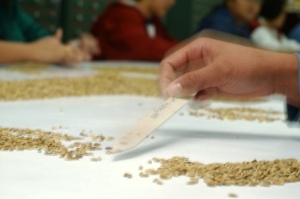 IRRI staff selecting good seeds for storage to the IRRI Genebank facility (photo: IRRI) |
For Base Collection
- 2 x 60 g sample.
- 2 x 100 grains for initial viability testing.
For Active Collection
Bulk sample for active collection
- 2 (for normal accessions) up to 5 (for the most popular accessions) x 10 g samples to be pre-packed ready for distribution.
- 2 x 200 grains for initial seed health evaluation.
For black-box safety backup storage
- 2 x 15 g for safety backup storage (one for Svalbard and one for another recognized genebank with long-term storage accepting black-box safety backups).
For temporary storage to repeat regeneration of harvests with insufficient seeds (<30 g) or inadequate initial germination rate (< 85%):
- 1-5 x 10 g samples for paper pre-packs.
- Place the cleaned samples again in the drying room while waiting for the viability and seed health test results.
- Encode all related information.
Special treatments
- If the recommended best practices are followed for seed drying, no extra treatment is necessary (drying seeds to the recommended level inhibits fungal growth and insect infestation).
- If seeds cannot be dried and kept dry sufficiently, fumigate as required whenever a build up of storage insects becomes noticeable.
Disposal of contaminated material
- Incinerate contaminated material.
Inspection and certification (purity analysis of seeds)
- Retrieve the accession number of all the harvested material.
- Retrieve the corresponding seed files (the seed file provides information of the sample composition and guides the selection process).
- Determine and compare the composition of the harvest with the seed file or the remnants of the planting material if the seed file is not available.
- Identify the obvious mixtures/off-types, if present.
- If the harvest does not represent the original sample, trace back for possible errors. If there are doubts on the sample composition, place the harvest on hold and repeat planting, making additional observations during the growing period, especially of the traits that differ in the initial harvest. Genotype DNA if needed.
- If the new seed lot does not totally represent the original sample, discard the seed and record WH (Wrong Harvest) as the harvest status in the documentation system.
Notes
Certain changes in seed phenotype may occur even though the seeds remain genetically true-to-type:
- Seed introduced from other environments may produce grain of different size in the seed multiplication environment.
- Hull pigmentation is more intense when grown under moist conditions.
- Harvests from screen house and field differ in hull colour intensity.
Methods
1st stage of drying (during seed cleaning)
- Immediately after threshing place the seeds in net bags and store in a drying room maintained at 15oC and 15% relative humidity (RH).
- Spread the samples evenly on the drying shelves.
- Mix the samples by turning the bags daily.
- Monitor the moisture level.
- Transfer the dried samples to paper bags when the moisture is less than 10% moisture content (MC).
2nd stage of drying (after seed cleaning)
- After cleaning, and sub-sampling for testing, place the selected samples back in the same drying room for 1-2 weeks while waiting for the viability and seed health results (during the seed selection process, seeds take in moisture).
- Test the moisture content.
- Monitor conditions in the drying room (with pre-set humidity and temperature, moisture testing is needed only infrequently).
- Test more often if fluctuations in RH are observed.
Alternative drying
- If facilities are not available for drying at 15oC and 15% RH or if the drying equipment is not working reliably, dry with self-indicating silica gel in moisture-proof containers.
- Repeatedly replace the silica gel until it stops absorbing moisture.
 |
 |
 |
|
Dissecators with silica gel |
||
Drying time
- Minimum of three weeks.
Moisture content before drying
- 9-20%.
Moisture content for storage
- 6-7%.
Critical moisture content
- 8% (below this level no insects or fungi affect the seed).
Recording information during seed cleaning and drying
The following information should be recorded for each processing step:
-
AccID [Unique Genebank Accession ID. Note a technical distinction between accession number and accession ID.
- A number, unique within a collection, (the accession number) is often used by genebanks and is sufficient for genebank management purposes.
- However, for all public documentation that number should be prefixed with a code to identify the collection and thus create an ID that is unique across genebanks: the combination of prefix and accession number then is a public accession ID].
- Cropping season (year and season of seed multiplication).
- Germination % (2 replications; initial % of germination of freshly prepared seed).
- Germination date (date of germination test).
- Packaging date (month and year of packing).
- Amount_bulk [amount (g) stored in bulk package in the active collection].
- Number_paper packs [number of paper packs retained for repeat multiplication – (for temporary storage only, if the viability or Seed Health test results are below the acceptable limit)].
- Number_apack (number of small aluminium foil packets for storage in the active collection, pre-packed with 10 g dried seed ready for distribution).
- Amount_base [amount (g) stored in base collection].
- Plant_mat (sufficiency of planting material for harvests that requires another round of seed multiplication).
- No. of Rows (approximate number of rows that could be planted for seed multiplication using the available planting material).
- Harvest_stat [status of harvest (insufficient, mixed, diseased)].
- Active tray ID (ID of the tray where the sample is stored in the active collection).
- Base tray ID (ID of the tray where the sample is stored in the base collection).
- Amount for duplicate storage1 (mark X if a sample has been prepared for the primary black-box safety duplicate storage genebank).
- Amount for duplicate storage 2 (mark X if a sample has been prepared for duplicate storage in Svalbard, Norway).
- Insects and pests (degree of insect and fungal damage).
Determination of seed moisture content
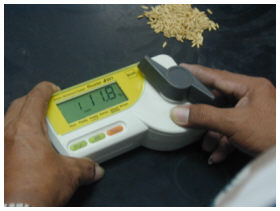 Using a moisture meter to check the moisture content of seeds (photo: IRRI) |
Methods
The recommended method follows ISTA rules.
Sampling frequency
Before storage
- Fresh harvest - measure moisture content on representative samples one week and two weeks after harvesting (the MC reading will determine if the seed is safe and could be transferred to paper bags to provide enough space for the incoming harvest).
- For the dried seeds - measure moisture content on representative samples five times/year and on every major fluctuation in RH reading.
- When the drying room is kept at constant 15% RH, expected equilibrium MC is maintained.
During storage
- No MC test is needed, provided best practice is followed for storing seed in moisture-proof containers.
- Seeds for base collection should be vacuum packed in one piece aluminium and rubberized lid.
- Seeds for active collection should be packed in high grade aluminium foil bags with small silica bag inside.
- Repacking should be done in low RH packing rooms and small silica bag replaced with the activated sample.
Before germplasm movement
- No MC test needed.
Sample size
- 5 g per sample.
- A sample of five representative accessions spanning a range of grain sizes.
Grinding
- Grind the sample until 50% of the sample is about 0.5 mm particle size and less than 10% of the sample has particle size > 1 mm.
- Weigh the metal container with cover and add 5 g ground sample.
Oven drying
- Set the oven at constant 130°C for two hours. The counting of the time should start when the oven stabilizes at 130oC.
- Take the seeds out of the oven and place them in desiccators for one hour.
- Take the final weight.
- Calculate the percentage of moisture content by: % MC = (Initial Wt - Final Wt) *100/Initial Wt.
Recording information during determination of seed moisture content
- AccID (Unique Genebank Accession ID).
- Cropping season (year and season of harvesting the seed).
- Sample number (sample ID).
- Testing date (date of testing).
- Replication [replicate number (1 or 2)].
- Initial weight (weight of ground sample before oven drying).
- Final weight (weight of ground sample before oven drying).
- % MC (computed value of the percentage of moisture level).
In vitro bank (cultivated rice, wild rice and related genera)
Contributors to this page: T.T. Chang Genetic Resources Centre-IRRI, Philippines (Ruaraidh Hamilton, Ken McNally, Flora de Guzman, Renato Reaño, Soccie Almazan, Adelaida Alcantara, Elizabeth Naredo); WARDA, Cotonou (Ines Sánchez); UPLB-University of the Philippines at Los Baños (Teresita Borromeo).
Provides guidelines and recommendations about the best practices for the daily management of genebanks, describing when and how in vitro genebanks should be used for rice. Best practices are shown in a pale blue color with bullets. Justification for each best practice is given within brackets (…).
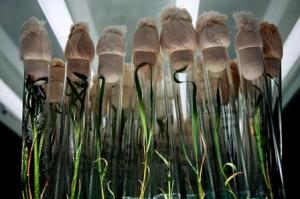 Rice plants being propagated using tissue culture. (photo: IRRI) |
What is it?
In vitro culture is a useful way to conserve a portion or a whole live plant growing under an adequate artificially controlled environment. Selected parts of the plant are generally grown in sterile glass containers with selected medium (a careful combination of nutrients, vitamins, sucrose, hormones and solidifying substrate) under specific conditions of light and temperature.
Where do they exist?
In vitro banks for rice are not used at a wider scale. There are only a few worldwide, storing a limited quantity of rice samples, at the University of the Philippines at Los Baños (UPLB) and ??? (look for more information)
When should be used?
- In vitro techniques are often used when traditional techniques are not easy to implement, when accessions are difficult to main as seeds or as an alternative conservation method (that uses a controled environment, avoiding climatic changes and contamination of pest and diseases that naturaly occur in the field) for materials that are conserved as whole plants in the field. Many wild rice accessions need to be maintained in a vegetative form.
- Tissue culture techniques are also used in genebanks to ensure survival of seed lots with low viability (this happens often when new seed lots are received at a genebank for long term conservation). Check here for more information how is this done at IRRI.
- In vitro techniques are also often used for quarantine purpuses to eliminate diseases; to facilitate multiplication and distribution of vegetatively propagated materials or on molecular characterization (but these are not detailed here).
|
On this page: |
Pre-treatment
- Apply regular insecticide and fungicide treatments once and twice a month, respectively.
Collection of materials
Parts of the plant
- Use young stems or young shoots as starting material.
Time of the year
- They can be collected whole year round.
Size
- Use about 8-10 nodes, of aproximately 15cm long each.
Maturity
- Use preferably young or newly grown materials.
Special care
- Special care (disinfection of cutting tools) - dipping/soaking of scalpel/pruning shears in detergent and 95% alcohol.
Cleaning
(to reduce the contamination to less than 30%)
- Wash shoots in soap and water.
- Soak in fungicide for 5min.
- Rinse with distilled water.
- Soak/quick rinse in 70% ethanol for 1min.
- Soak in 10% commercial bleach for 10min.
- Rinse 3 times with sterile distilled water.
Starting material
- Use 1-2 nodes containing axillary buds and shoot tip of approximately 5mm size.
Visual inspection of plant materials
- Observe for insect damage, fungal/bacterial diseases and viral symptoms.
Disposal of contaminated materials
- Autoclave contaminated cultures.
Recording information during sample processing
- Passport data (accession number).
- Culture data:
- Source of explants/place of collection.
- Date of collection.
- Date of culture/inoculation.
- Culture media.
- Symptoms for diseases (presence/absence of diseases).
 |
 |
|
Growing a culture (photo: IRRI) |
Tissue cultures of Rice plants with the vitamin A genes being grown inside a light room at IRRI. (photo: IRRI) |
Routine monitoring methods
Plant quality/viability
- Observations - survival and growth.
- Frequency - monthly.
- Tests - visual observations.
- Frequency - monthly.
Bacteria contamination
- Observations - types of bacterial contaminants.
- Frequency – weekly.
- Tests – visual observations.
- Frequency – weekly.
Genetic integrity (to detect genetic changes and mixtures) (look for recommendations from other genebanks)
- Observations - ?
- Frequency - ?.
- Tests ?
- Frequency ?
Need to rejuvenate/multiplicate
- Minimum quantity/viability of stocks: the number of plants depends on the needs.
Recording information during monitoring
- Passport data (accession number).
- Culture data (source of explant/place of collection).
- Date of inoculation (date of culture/inoculation).
- Culture media.
Types of storage for in vitro banks
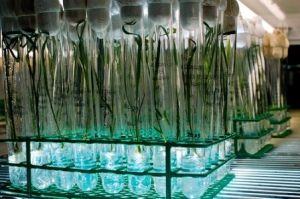 Tissue culture in bottles. (photo: IRRI) |
Standard tissue culture
When should be used?
- For conservation and micro-propagation.
Sample specifications
Type of plant samples
- Use shoot tips and/or nodal cuttings.
Size of sample
- Use 6-8 bottles per accession (replicates per accession).
Type and size of container
- Use 2-4 plantlets per bottle in ampicillin bottles or vials with about 120ml.
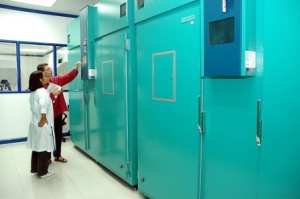 Scientists at IRRI checks the growth chamber for tissue culture in the Tissue Culture Laboratory. (photo: IRRI) |
Storage specifications
Growth media
- Use Murashige and Skoog (MS) macro, micro and vitamins and amino acids.
- Composition (nutrients, pH): 30g/L sucrose, 5g/L agar.
- Special components: pH = 5.7.
Culture facility regimes
- Light level/intensity: 30-50µmoles/sec provided by two 40 watt fluorescent lamps.
- Photoperiod: 8h.
- Day/night temperatures: 27-28oC/ 25-26oC.
Storage duration (time without sub culturing)
- Average - 4 months.
- Minimum and maximum range - 3-5 months.
System for tracking materials/inventory system during tissue culture storage
- Inventory of cultures every sub-culture time.
Recording information during standard tissue culture storage
- Accession data.
- Source of explant.
- Date of inoculation.
- Date/Number of subculture.
- Media.
- Culture conditions.
- Losses.
Storage of cultivated rice genetic resources
Contributors to this page: T.T. Chang Genetic Resources Centre-IRRI, Los Baños, Philippines (Ruaraidh Sackville Hamilton, Ken McNally, Flora de Guzman, Renato Reaño, Soccie Almazan, Adelaida Alcantara, Elizabeth Naredo); WARDA, Cotonou, Benin (Ines Sánchez); UPLB-University of the Philippines at Los Baños (Teresita Borromeo).
|
Contents: |
When it should be used
- A base collection should be held only by a genebank with mandate and responsibility for secure long-term conservation.
- A sample of every unique accession should be stored in a base collection.
- A genebank with only an active collection and no facilities for long-term conservation should make arrangements for long-term conservation of its unique germplasm in the base collection of another suitable genebank.
-
Accessions conserved in a base collection should never be used, except:
- To regenerate seed for the base collection when viability decreases below the threshold.
- To regenerate seed for the active collection when the only available source for planting in the active collection is four generations from the original seed, or when a problem in managing the active collection has resulted in the total loss of seed from the active collection.
- For scheduled viability monitoring.
- In the event of accidental loss of all seed from the active collection.
Sample specifications
Minimum sample size for storage
- 120 g (2 cans).
Minimum viability for storage
- 85% (for some accessions even newly harvested seed has viability lower than 90%).
Moisture content
- 6-7%.
Container specifications
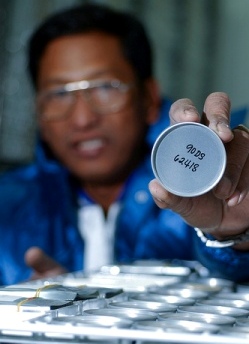 Aluminium (corrosion free) can (photo: IRRI) |
Seed packaging method
- Use a specially designated seed packing, labelling and weighing room, situated adjacent to the seed drying room and with humidity reduced using a dehumidifier.
- Prepare two aluminium cans per accession (two separate cans per accession improves security and management, enabling half the accession to be kept packed in the event that it is necessary to remove seed).
- Prepare barcoded labels with the following printed information: accession number, name, crop year, Seed Lot ID, tray ID for storage and barcode. The barcode itself contains the Seed Lot ID.
-
Label each can with:
- Accession ID and crop season written on the body using permanent marking pens.
- Bar-coded label affixed to the lid.
- Small paper labels printed with accession ID and crop season, placed inside the cans.
- Arrange the cans in the packing area, in the order of taking samples out of the drying room.
- Take only a few samples at a time from the drying room (to minimize reabsorption of water during packing).
-
For each sample, find its two corresponding labelled cans and double check that all labels match.
- The label inside the cans, on the lid, outside on the body and on the packet retrieved from the drying room.
- Pour seeds into can.
- Vacuum seal in semi-automatic can sealer at 20 PSI.
- Check for deficiencies in the can: if there is any deficiency, discard and repeat labelling and packing with a new can.
- Weigh the can (tare to the weight of an empty can) and record weight in the database using the inventory management system.
Specifications of packaging material
- Aluminium (corrosion free) can volume 100 cm3 (e.g. 6 cm diameter * 3.5 cm high) to hold 60 g rice, strong enough to withstand vacuum packing.
- Air-tight and moisture-proof seal.
- Special-purpose high-quality labels created with material, adhesive and print designed to survive 100 years at 0-100% humidity and - 20°C to +30°C, e.g. from CILS International.
Storage specifications
Assigning location codes
- Label shelves and trays in the long-term cold store.
- Record in the database the number of accessions that can be accommodated on each tray.
- Using the database inventory management system to query the locations of used and unused trays, find the next available unused location in the cold store.
- Knowing the number of cans per tray, determine the tray number to be used for each accession in the batch to be packed.
- Assign that number to be printed on the label of each container (printing the tray number on the label facilitates accurate management of the store, including returning the can to the correct location).
Storage conditions
- -18 to -20°C.
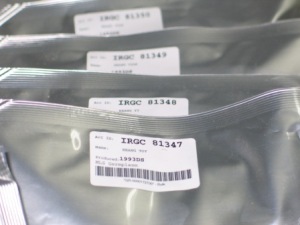 Moisture-proof laminated aluminium foil packaging for active storage (photo: IRRI) |
When it should be used
- An active collection should be maintained by a genebank with mandate and responsibility to distribute seeds to users.
-
Samples conserved in the active collection should be the normal source of seed for use, including to:
- Distribute seed to users.
- Regenerate seed for the active collection, for up to three generations from the original seed.
- All other genebank purposes, including characterization, viability testing and other genebank research activities.
Sample specifications
Minimum sample size for storage
- Sufficient to establish two plots for regeneration with a safety margin – an amount of 60 g.
Target quantity for initial storage
- Typically 0.5-1 kg depending on expected demand.
- Use a larger quantity for heavily used accessions.
- Use less quantity for rarely-used accessions.
Viability for storage
- 85% of initial viability.
Moisture content
- 6-7%.
Container specifications
Seed packaging method
- Use a specially designated seed packing, labelling and weighing room, situated adjacent to the seed drying room and with humidity reduced using a dehumidifier.
- Prepare containers (preparing ‘pre-packs’ for distribution in advance increases initial packing costs for storage but substantially reduces re-packing costs for distribution and re-storage. It is strongly advised for heavily used collections.
- For little used collections it is more effective to store only bulk samples (with a smaller than average amount than in heavily-used collections):
- Normal accessions: one large pouch for the bulk and two ‘pre-packs’ for distribution.
- Popular accessions: two large pouches for the bulk and five ‘pre-packs’ for distribution.
- Prepare barcoded labels for the bulk samples, with the following printed information: accession number, name, crop year, Seed Lot ID, tray ID for storage and barcode. The bar-code itself contains the Seed Lot ID.
- Prepare labels for the aluminium pre-packs, labelled with the same information as for the bulk sample but without a barcode.
- Prepare small samples of activated self-indicating silica gel (1 per bulk pouch) in a sealed plastic pack.
- Affix labels to the bulk and pre-packs and arrange them in the packing area in the same order in which they will be withdrawn from the drying room.
- Take only a few samples at a time from the drying room (to minimize reabsorption of water).
- For each sample, find its corresponding labelled bulk and pre-pack pouches, and double check that all labels match.
- Pour 10 g aliquots of seed into each pre-pack and seal using high temperature constant heat sealer (HM 305 CTE Constant Twin Element laminate crimp sealer, supplied by Hulme-Martin Ltd.) with 1 cm seal width.
- Pour the rest of the sample in the pouch(s) for the bulk sample.
- Perforate one packet of silica gel and place it in the foil pouch just before sealing (the silica gel serves a double purpose, to remove moisture that may have been absorbed during the packing process and to indicate cases of leakage during storage).
- Seal using the high temperature constant heat sealer.
- Check for packing deficiency.
- Reseal or replace if there is any deficiency.
- Weigh the bulk pouches and record weight in the database using the inventory management system.
Specifications of packaging material
- Moisture-proof laminated aluminium foil with wide seam on all sides (re-sealable aluminium foil is more convenient for active use with frequent re-packing than the hard aluminium cans recommended for the base collection).
- For bulk storage: use large pouches, approx 24 cm x 16 cm.
- For distribution use pre-packs: small pouches, approximately 11 cm x 8 cm. (pre-packs are small pouches containing a 10 g sample of rice pre-packed ready for use, before it is actually needed. Aluminium pre-packs are for distribution to users. Preparing them in advance substantially reduces packing and re-packing costs in a well-used genebank).
- Special-purpose high-quality labels created with material, adhesive and print designed to survive 40 years at 0-100% humidity and 2°C to +30°C, e.g. from CILS International.
- To reduce costs, lower quality labels may be used for the pre-packs.
Storage specifications
Assigning location codes
- Arrange the packed seeds side by side in a numbered tray according to accession number.
- Assign tray number corresponding to the accession number.
- Place and arrange the tray consecutively in the Active Collection room.
- For accessions without bulk samples, a temporary tray number is assigned until a bulk has been prepared.
Storage conditions
- 6-7%.
For information on safety duplication, click here.
Storage space arrangement
These practices are based on manual operations, not on robot-mediated deposits and withdrawals.
 |
Room
- Walk-in cold store, height 3-5 m, heavily insulated.
- Redundant cooling equipment with backup failover mechanism, placed outside under shade to facilitate heat exchange.
Shelf stacks
- Parallel stacks, in two rows against opposite walls with 2 m passage between rows.
- Height to about 0.5-1 m below ceiling.
- Total depth about 1 m per shelf, with racks/slots on both sides for removable trays.
- Mobile shelves mounted on wheels on tracks, with rotating handles to move the shelves, geared to facilitate easy movement even when fully loaded, to enable denser packing of the cold store.
- When positioned to maximize space between one pair of shelves, the distance between them is about 1 m, to facilitate the withdrawal of trays.
- Labelled with a shelf ID corresponding to ID used in the database.
Trays
- About 0.5 m deep (half shelf depth).
- Height enough to accommodate a single layer of seed packets with room to slide in and out.
- Labelled with a tray ID corresponding to the ID used in the database.
System for tracking material/inventory system
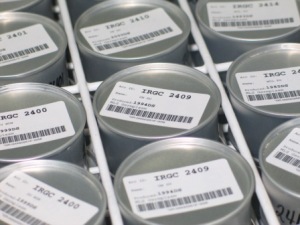 |
|
Bar-coded labels (photo: IRRI) |
Preferred option: barcoded inventory
- Ideally use barcoded labels with a barcode reader and balance linked to the genebank database through a computerized inventory management system.
- For samples with the amount recorded in grams for the inventory (i.e. bulk sample for the active collection, and the sample for the base collection), before a newly-packed sample is placed in storage, and subsequently each time seed is removed from it and repacked, for whatever purpose, weigh or re-weigh the seed before replacing the sample in storage. The inventory management system will automatically update the inventory.
- For samples with the amount recorded as number of packets (i.e. aluminium pre-packs for the active collection, aluminium pre-packs for safety backup, and paper pre-packs for other immediate uses), the number of packets added or remaining is automatically updated in the inventory by the inventory management system as part of the computer-controlled processes of storing new seeds and distributing samples to users.
Alternative option: inventory management without barcodes
-
Bulk sample in active collection:
- Before a newly packed bulk sample is placed in storage, weigh it and record the weight manually in the inventory.
- Each time the bulk sample is removed to extract seed (e.g. to make new aluminium pre-packs or for direct local use), subtract the amount removed from the amount recorded in the inventory.
- Once every ten years, undertake a complete manual inventory of the active collection, to correct the errors that gradually cumulate by recording amounts removed cumulatively rather than the amount replaced in storage.
- For samples with the amount recorded as number of packets, use the same procedure as described for barcoded system.
- Base collection: record the amount as number of cans, not grams, and maintain inventory as for pre-packs.
Recording information during storage
The following information should be recorded for each step:
- Accession ID (ID of accession).
- Seed Lot ID (ID of this sample of the accession).
- Crop season (year and season the seed was harvested).
- Store type (temporary, active bulk, active pre-pack, base, primary safety backup, secondary safety backup (type of storage and packing for this sample).
- Location in storage (shelf and tray number (temporary, active, base).
- Species (O. glaberrima or O. sativa).
- Germination % (two replications) (germination % - separate values for each replication; new record for each test).
- Germination test No. (number of seeds per replicate used for testing germination %).
- Germination date (date of germination test; new record for each test).
- Seed amount units – grams, number of packets (units used to record the amount of seed of this sample).
- Seed amount (amount of seed in store; new record for each update).
- Inventory date (date the amount was last updated; new record for each update)
Distribution of cultivated rice, wild rice and related genera genetic resources
Contributors to this page: T.T. Chang Genetic Resources Centre-IRRI, Los Baños, Philippines (Ruaraidh Sackville Hamilton, Ken McNally, Flora de Guzman, Renato Reaño, Soccie Almazan, Adelaida Alcantara, Elizabeth Naredo); WARDA, Cotonou, Benin (Ines Sánchez); UPLB-University of the Philippines at Los Baños (Teresita Borromeo).
|
Contents: |
Policies and regulations for distribution
Common policies on distribution and access to plant material
- Establish a single 'gatekeeper' for all germplasm movement into and out of the organization, with a mandate to check for compliance with all necessary procedures and to advise staff what documents are needed and how to obtain them (to ensure full institutional compliance with obligations for germplasm sharing).
- Most scientists working with germplasm do not understand the complexities of the policies and required procedures for germplasm distribution. Routing all germplasm distribution through a group of trained experts ensures that the institute complies with its obligations, even though most of their staff does not know those obligations.
- Ensure that all staff (including the shipping office if the institute has one) know that all incoming and outgoing consignments of germplasm must be routed through the gatekeeper (to ensure that institutional policies are not bypassed).
-
All germplasm shipments must be governed by a Standard Material Transfer Agreement (SMTA) or other contract (it is essential to know the rights and obligations of both the provider and the recipient of the germplasm shipped:
- Where possible and appropriate for the germplasm and purpose of transfer, use the Standard Material Transfer Agreement SMTA (all species of Oryza are included within the multilateral system of the Treaty. Use of the SMTA for all possible shipments, including cases where use of the SMTA is voluntary, simplifies administration of germplasm distribution) including: breeding and research material, as well as genebank accessions, germplasm from non-Party countries as well as Party countries and germplasm not under state control, as well as under state control.
- Document the Intellectual Property (IP) status of all germplasm in the database, including any restrictions on its use and conditions under which it may be distributed (essential to ensure that the institute allows only duly authorized distribution and use of germplasm).
On receipt of any germplasm request:
- Send acknowledgement of receipt of germplasm request.
- Inform requestor of procedures and requirements, including obligations and rights associated with the transfer.
- Ask the requestor to confirm acceptance of the conditions (verifying that the requestor is willing and able to comply with all conditions prevents unnecessary investment of resources in preparing a consignment that cannot be shipped).
- In the database, assign a germplasm request ID and record the details of the requestor, the request and the purpose (records must be kept of all transactions, both for the purpose of tracking progress through handling a germplasm request and for subsequent reporting on germplasm distribution).
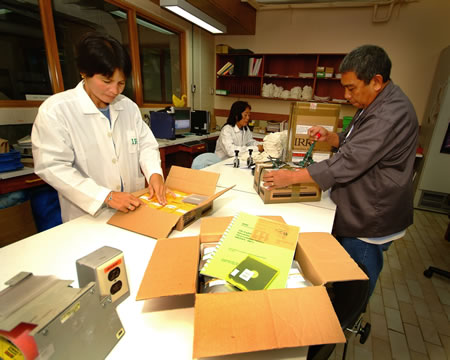 Seeds are packed in different packing materials (coin envelop, cloth bags, foil packs, tin cans and net bags) depending on the type of seed material and place of destination (photo: IRRI) |
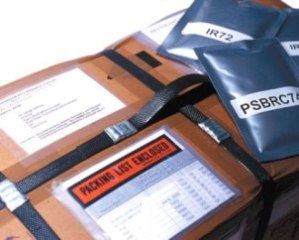 Packed seeds ready to be sent out (photo: IRRI) |
Policy exceptions
- No MTA is needed for distribution within an organization (e.g. from genebank to breeder), unless desired for awareness-raising (distribution within a legal entity technically does not normally need an (S)MTA, assuming the organization takes corporate responsibility to comply with obligations; however, if there is doubt whether staff are aware of their role in complying with institutional obligations, use of an internal MTA can be a valuable tool for raising awareness).
-
Do not use the SMTA for purposes outside the scope of the SMTA, i.e. for use other than for breeding, research and training for food and agriculture, including:
- Non food/animal feed use.
- Direct commercial use.
- Undertaking specific tests as a service for the provider, not as part of the recipient’s own research.
National laws and regulations
- Exporting country may require an export permit.
-
Importing country may require:
- Import permit.
- Phytosanitary certificate.
- GMO declaration.
- Customs declaration.
International laws and regulations
- The seed shipment should be sent with the Standard Material Transfer Agreement (SMTA and MTA) even for non Annex I species using appropriate footnotes (CGIAR centres have signed an agreement with the ITPGRFA (plant treaty) which covers use of the SMTA).
- For wild rice, many countries require special import permits because of its status as noxious or invasive species; such permits may be issued only to organizations with recognized and regulated containment facilities preventing the escape of material into the environment.
Phytosanitary regulations
- Phytosanitary certificates are needed for most countries.
- See general guidelines on this site for safe transfer of rice germplasm (this is essential to avoid the spread of pests and diseases) and health diagnosis for rice.
User related issues for distribution
A successful effective distribution involves a protracted dialogue and collaborative exercise between genebank and user.
Feedback to users
Items requiring feedback to user include:
- Send acknowledgement of receipt of request.
- Inform requestor of procedures, required documents and the recipient’s rights and obligations over germplasm transferred, and answer any related questions the requestor may have.
- Ask the requestor to confirm acceptance of the terms and conditions of the transfer and in particular of the MTA.
- Ask the requestor for clarification of doubts, e.g. about the germplasm requested, about arrangements for shipping, or about apparent errors or other discrepancies in information provided by the requestor.
- Inform the requestor of the likely time frame for completing the request.
- If the request did not include a list of specific accession IDs, notify or consult with the user how accessions will be selected based on the requestor’s criteria.
- Inform the requestor of the availability of selected accessions and suggest alternatives for unavailable accessions.
- Ask the requestor to confirm the final selection of accessions before preparing them for distribution.
- Inform the requestor when the consignment has been shipped.
- Give the requestor access to associated information on the accessions.
Processing time
May be one day for internal transfers without MTA or health testing, one week for local transfers, one to two months for international transfers including seed testing.
Processing time will depend on:
- How specific the request is – longer time is needed for ill defined or ambiguous requests requiring additional consultation with the requestor, and for requests requiring detailed analysis to choose suitable accessions.
- The number of accessions requested.
- Seed health testing and phytosanitary requirements.
- The difficulty of obtaining an import permit from the importing or the exporting country.
- The duration of shipping.
- Post-import quarantine procedures of the importing country.
- The need to coordinate shipping date with the requestor’s planned sowing date.
When the request is not clear
- If the request is not clear or appears to contain errors or other discrepancies, ask the requestor to clarify (the recommended best practice is long and often cumbersome. It reflects current reality in the way requests should be handled to make them as effective as possible. The detail also reflects the importance of matching distribution to needs).
When the request is specific
- If the request specifies a list of particular accession IDs, check those accessions for availability (see 'check availability' section below) inform the requestor (the key to making a good selection of accessions to distribute is to have ready access to data relevant to users’ requests: future improvements in the nature, quality and availability of relevant data may be expected to simplify the operation and improve its effectiveness).
- For accessions that are not available, suggest alternative providers or alternative accessions.
When the request is not specific
- If the request does not list particular accession IDs, it will be necessary to choose a set of accessions to satisfy the requestor’s needs. This will involve deciding first how to choose the set.
Choosing the sources of information
First steps:
- Assess the request to judge the best source(s) of information on which to base a response:
-
- The genebank’s own database.
- Other databases accessible to the genebank curator.
- Personal knowledge held by the curator or other genebank staff.
- Published works or other information on the Web.
- Knowledge held by other experts in the same institution – in this case, consult the relevant experts to seek their advice.
-
If the information required to select appropriate accessions is available online, inform the requestor and offer two options:
- The requestor performs the online search.
- Genebank staff or other relevant experts perform the search on behalf of the requestor.
-
If the information search is not straightforward, for example:
- it requires a complex GIS or other statistical analysis; or
- the request specifies criteria on which there is no information, and can only be satisfied by specifying a surrogate search representing a best guess at the information that could be used for selecting accessions (e.g. the requestor is searching for resistance to a new disease on which there is no prior information);
- then consult further with the requestor: tell the requestor what other potentially relevant data are available, propose a surrogate search or analysis, and seek agreement on how to choose appropriate accessions.
- If the search requires an analysis too complex and protracted for routine application, and if the request comes early enough during the requestor’s proposed research programme, consider suggesting participation as a full collaborator in a project proposal to ensure the optimal choice of accessions.
- If no agreement can be reached on criteria for selecting accessions to meet the requestor’s needs, consider offering a core collection selected for diversity; this will at least provide the user with a wide range of material for initial studies, albeit not matched to the user’s needs.
Deciding for a wider search:
-
Based on the request, information available and agreed selection strategy, assess whether to search only among the accessions held by the genebank or to extend the search to include other genebanks or germplasm held by others outside the genebank, e.g. breeders or other scientists in the same institute or elsewhere.
- If appropriate, forward the request to possible providers of appropriate germplasm and request feedback from them.
- If appropriate, hand over responsibility for satisfying the request to the most appropriate provider.
- If there will be more than one provider, consider whether to consolidate into one transaction (e.g. if the providers are different scientists from one legal entity) or process as different transactions.
Last steps:
-
If the above process leads to a search of accessions from the genebank, conduct the specified search and generate a list of selected available accessions:
- Option 1: restrict the search only to available accessions.
- Option 2: search all accessions, and subsequently verify their availability (see check availability section below).
- Send a list of suggested genebank accessions to the requestor and ask whether the list is acceptable.
- Repeat consultations, searching and verifying availability as often as necessary until the requestor accepts the proposed list of accessions.
Feedback prior to shipment
- Criteria for selecting appropriate accessions, as precisely as possible (the clearer the request, the easier to select accessions – the easiest case is a list of accession IDs provided by the requestor).
-
Statement of purpose:
- Essential: an SMTA cannot be issued without knowing that the requestor’s purpose complies with the SMTA.
- Desirable: knowing the requestor’s purpose can improve the selection (for example if a variety name is specified without an accession ID and multiple genetically distinct accessions share the same variety name, knowing the purpose may help to identify which particular accession ID is wanted).
-
Acceptance of terms and conditions:
- Essential to obtain a statement from the requestor that the terms and conditions of transfer are accepted.
- Desirable to seek acceptance early, to avoid wasting efforts for users that cannot accept.
- Import permit, if required.
- Additional phytosanitary requirements (countries’ phytosanitary regulations change; often the best way to keep up to date is for the requestor to provide the latest information on the specific requirements of the requestor’s country).
- Desired shipping date to accommodate planting date (in some cases it may be essential to coordinate closely with the requestor’s intended planting date. For example, some countries require all seed to be heat-treated to kill nematodes; seeds must be planted within one month of such treatment or they will die).
- Desired shipping arrangements: method of shipping, port of entry, consignee’s name and address, shipping address.
Feedback after shipment
- The requestor should notify when the shipment is received in good condition (not required, but desirable as it marks the successful end of the shipping process).
- Research results obtained by the user (not required, but desirable as it helps build the body of knowledge on diversity in the collection).
Quantity of material recommended to be distributed
Cultivated rice
- 10 g per accession - free of charge (sufficiently large to satisfy most research purposes and even for use by farmers, especially after seed increase by recipient; sufficiently small to enable many samples to be distributed from a single seed increase by the genebank).
- Larger quantities may be subject to charges for shipping and preparation costs (distribution of larger quantities typically requires additional cycles of regeneration, requiring larger-than-routine financial investment by the genebank and potentially increasing delays for other users.
Wild rice
- 20 seeds per accession (wild rice species produce only small quantities of seeds).
Initial preparations
Registering the request
- Register all requests in the database, assigning a request ID, with information on the request, the requestor, and the date (this step should be the first action on receipt of a request).
- Requests may also be registered in a paper log book.
Monitoring progress through the request
- If available, use a computerized genebank management system to monitor progress through each request.
- For streamlined management of large numbers of requests, details and current status and completed elements of each active request should be recorded temporarily (for as long as the request is actively being processed) on a white board or similar display visible to the whole team.
Initial interaction with requestor
- Send a letter of acknowledgement to the requestor.
- Inform the requestor of procedures, required documents and the recipient’s rights and obligations over transferred germplasm, and answer any related questions the requestor may have (necessary to guard against unintentional inappropriate use of the germplasm by the requestor).
- Ask the requestor to confirm acceptance of the terms and conditions of the transfer and in particular of the MTA – either in person, if so authorized, or through the authorized representative of the requestor’s institute (necessary as early as possible to avoid wasting resources on a consignment that the requestor cannot accept).
-
If the requestor does not accept the terms and conditions:
- Negotiate revised terms and conditions if possible and appropriate.
- Cancel the request if negotiation is not possible (e.g. for the SMTA) or if negotiations fail.
- Inform the requestor of the likely time frame for completing the request.
-
Ask the requestor to provide:
- An import permit, if required by the requestor’s country – original, or paper copy or electronic copy depending on the regulations of the requestor’s country.
- Any additional information on specific phytosanitary tests to be conducted.
- Desired shipping arrangements: method of shipping, port of entry, consignee’s name and address, shipping address.
Selection of germplasm for distribution
Follow the procedures specified in customer assurance, ensuring full interaction with the requestor as specified in the feedback to users and feedback from users, to produce:
- A list of accessions to be provided by the genebank.
- A list of other germplasm samples to be provided by others in the same legal entity and shipped in the same consignment.
- A list of other germplasm samples to be independently provided by different organizations.
Genebank procedures to select germplasm
These should only apply to accessions to be provided by the genebank.
Check seed/plant propagules
- Not necessary if best practices have been followed for initial seed processing and storage (the identity of all accessions should have been verified against the seed file prior to processing and storage).
- If seed were not verified against the seed file prior to storage, do so prior to distribution.
Availability in stock and the requirements for material transfer agreements
- Check the IP status of the accession in the database to determine whether legal / IP status of the accession prevents its distribution (an accession is available for distribution only if it was obtained or developed under conditions that permit distribution. The database should contain information on the legal availability of each accession, including the conditions for distribution, e.g. whether it is available for distribution with SMTA under the multilateral system of the Treaty).
- Use the inventory management to assess availability and identify the particular seed lot to be used.
-
The accession is available if:
- A pre-pack is available (this is a top priority for satisfying requests) – this will be used to satisfy the request; or
- A pre-pack is not available (this is a second priority for satisfying requests) but the bulk sample of the most recent generation of the accession still has more than the minimum quantity and viability of seed and has passed previous routine seed health tests – this bulk sample will be used to satisfy the request and at the same time to create additional pre-packs.
- The accession is not available if neither of the two previous conditions is true (other seed lots of the accession should not be used for distribution. Remnant bulk samples of older generations of the accession in the active collection should be kept only for seed increase. Most Original Samples (MOS) and samples in the base collection are kept only for long-term conservation, not for distribution.
Preparing samples for distribution
List of accessions available
-
See also customer assurance section. Based on the agreement with the user, prepare a worksheet:
- Specifying Accession ID, Tray ID (location in storage), Seed Lot ID (the specific seed packet to be withdrawn, the amount to be withdrawn.
- Leave space for recording observations, errors in inventory, actual unavailability of seed (possible errors in the computerized inventory management system may result in the case that a database query shows an accession as available whereas in fact it is not).
- Sorted by Tray ID and accession ID (sorting by location in the cold store speeds the process of withdrawal).
Generating labels
-
For each accession to be retrieved from the cold store as a bulk sample, prepare labels as needed for new pre-packs as needed (usually three per accession):
- Usually one for immediate distribution in the current consignment.
- Usually two for storage in the active collection ready for future distribution.
- See the container specification of active genebanks section for wild rice and cultivated rice for label content and labelling procedure.
- If best practices have been followed for preparing pre-packs for distribution in advance (see the container specification of active genebanks section for the cultivated rice and the wild rice, new labels will need to be generated only for accessions where there are no remaining stocks of pre-packs. In this case, bulk packs will be withdrawn from the active collection, and new labels will need to be prepared for new pre-packs of those accessions).
- If pre-packs are not prepared in advance, this step will apply to all accessions and only one new pack will be prepared and labelled per accession, namely the packet to be shipped in the consignment.
Labelling the accession containers
See above and the container specifications of the active genebanks section for cultivated rice and wild rice: only newly-prepared pre-packs will be labelled.
Cross checking inventory files with actual seed stocks
While withdrawing the specified seed packet(s) (bulk and/or pre pack) of each accession (by this stage (preparing samples for distribution), the computer inventory should already have been checked for availability (in the previous check availability section), and only available accessions will appear on the list:
- Cross-check the actual presence of seed packets in the tray against the presence documented in the inventory management system and printed on the worksheet.
- Record on the worksheet any inventory discrepancies for subsequent correction in the database, updating the inventory records.
- Mark accession as unavailable if actual quantity is insufficient.
Removing containers from genebank and acclimatization procedures required
- Referring to the printed worksheet that lists the locations, accessions and specific seed lots of each accession (see List of accessions available above, in this section) withdraw the specified seed packet(s) (bulk and/or pre pack).
- Equilibrate at room temperature for 1-2 days before opening.
Ensuring accuracy in identification
- After withdrawing all packets, double-check packets against the proof sheet, checking for correspondence of Accession ID, Seed Lot ID, and variety name or other designation.
Correcting errors
- Correct the database for any errors discovered in the inventory.
- Change any packets withdrawn in error to the correct packet.
- If any accessions have had to be removed from the list because of inventory discrepancies, inform the requestor, suggest/negotiate alternatives, and modify the list accordingly.
Extracting samples from the original containers
- Separate the withdrawn seed packets into two groups: pre-packs and bulk packs.
-
For samples withdrawn as pre-packs:
- Set aside - they are fully ready for submission to export procedures with no need for opening or re-packing (except that subsequent phytosanitary testing may involve opening and resealing of some or all).
- Update the inventory management system by subtracting the number of pre-packs removed (normally 1).
-
For samples withdrawn as bulk packs:
- Transfer to the dehumidified seed packing room.
- Handle one accession at a time, cut open the bulk pack, check the status of the self-indicating silica gel, double check identity of labels on bulk and pre-packs, pour 10g seed into each labeled pre-pack, heat seal the pre-packs, place a newly perforated packet of silica gel in the bulk, re-seal the bulk, re-weigh the bulk and record its new weight in the inventory management system (further details in the container specification of active genebanks section for cultivated rice and wild rice).
- Set aside the pre-pack(s) prepared for the current consignment.
- Return the re-sealed bulks and the other new pre packs of each accession to the assigned location in the cold store.
- Update the inventory management system for stocks of pre-packs by adding the number of new pre-packs stored .
Final preparation by genebank
- Arrange all pre-packs for the current consignment by accession ID.
- Generate a final list for proofreading.
- Label by hand with a sequence number (numbering packets sequentially within a consignment facilitates subsequent tracking of samples through the remainder of the shipping process).
- Generate a final verified list.
Phytosanitary inspection and certification
- Assemble documents required for phytosanitary processing: import permit; specifications of tests required by the importing country; details of previous phytosanitary tests of the same materials.
- Submit the consignment with documents to the official phytosanitary testing authority in the country of the providing genebank (phytosanitary testing and certification must be undertaken by an approved body to ensure independent testing and certification, the phytosanitary authority is often separate from the genebank).
- Obtain the required phytosanitary certificate.
Preparing the information list to accompany the plant materials
Basic information
- Passport data.
- Accession identification.
- Source.
Biological status
- Follow the information as specified in the Bioversity International, IRRI and WARDA Rice Descriptors.
- All data must be provided electronically, either in an attachment to an email or on a web page (electronic transmission of data is essential for error-free incorporation of data into the recipient’s database).
Characterization data used to verify accessions
- Provide both the data and the key to the data.
- If available and appropriate, follow the key descriptors specified in the Bioversity International, IRRI and WARDA Rice Descriptors.
- Also provide data on any other distinguishing characteristics of the accessions even if not included in the key Bioversity International, IRRI and WARDA Rice Descriptors.
Cover letter
- Specify shipping arrangements.
- List accompanying documents and their location.
- Ask the recipient to acknowledge receipt.
- Send to the requestor electronically in advance, as well as accompanying the shipment.
Accompanying documents
Prepare and/or obtain the following documents as needed:
MTA
- Prepare the MTA as agreed with the requestor (as indicated above, preferably the SMTA if possible and appropriate). Preferably send electronic copy, as well as paper, copy with shipment.
- Ensure that the MTA is duly accepted by authorized representatives of both provider and recipient.
- If a signature is necessary, ensure that both sides sign before the shipment is sent.
Import permit
- Obtain an import permit from the requestor if required by the requestor’s country.
Customs declaration
- Declaration to conform to requirements of the requestor’s country, as a label, a form, or some other declaration depending on the destination country.
Phytosanitary certificate
- Obtain a phytosanitary certificate from the relevant authorities in the genebank’s country, in compliance with the requirements of the requestor’s country.
Export permit
- If required by the laws of the genebank’s host country, obtain an export permit from the relevant authorities.
GMO declaration
-
If the importing requestor or the requestor’s country requires it, prepare a statement declaring what measures have been taken to keep the germplasm free of transgenes. An example of a GM-free declaration from IRRI is given below:
- "We hereby certify that the rice seeds in this package were produced solely by conventional methods, without the applicaton of genetic modification technologies, and in isolation from any known source of potential contamination by genetically modified rice. To the best of our knowledge they are GM-free".
Type of information
- For shipments with SMTA, in addition to passport data, provide all available characterization and evaluation data in the genebank’s database (shipments with SMTA must be accompanied by 'any other associated available non-confidential descriptive information').
- If the requestor asks for other information that is not already made available as standard, take reasonable measures to obtain and supply the information from elsewhere.
Dispatching the plant material
Verification
-
Submit the completed consignment and associated documents to the organization’s gatekeeper for verification. The gatekeeper will:
- Check that the germplasm list corresponds to the germplasm samples.
- Check that the MTA is appropriate for the germplasm been transferred and purpose of transfer.
- Check that associated documents are complete, correct and complying with the requirements of the exporting and importing countries.
Packaging
- Aluminum foil bags tightly packed in cartons.
Reply form
- Send one reply form (to facilitate feedback).
Sending the plant material
- Normally send by airfreight.
- When the consignment has left the genebank institute, notify the requestor, recipient and consignee.
- If the shipper provides a reference number for tracking the shipment, send it to the requestor, recipient and consignee for their information.
Recording shipping details
Record the following information:
- Institute’s reference ID for the consignment.
- Shipper’s tracking ID.
- Date dispatched.
- Mode of shipment.
- Sender and institution.
- Consignee.
- Import Permit ID.
- Weight of consignment.
- MTA ID.
- Phytosanitary certification ID.
- Receipt ID.
- Acknowledgement receipt.
- Declared seed condition on receipt.
- Reference number.
- Crop name.
- Consignee’s name and designation.
- Name and address of organization.
- User information (type of organization requesting materials).
- Date of request.
- Date of supply.
- Number and quantity of samples provided.
- Phytosanitary certificate.
- Export permit number.
- Purpose.
- Remarks.
- Others.
System for tracking material/inventory system for distribution
- Distribution should be one of the modules of the genebank documentation system.
References and further reading
Agreement sample form. Available from: http://sgrp.cgiar.org/sites/default/files/AgreementwithCentresfinal1.doc. Date accessed: 15 June 2010.
Bioversity International, IRRI and WARDA. 2007. Descriptors for wild and cultivated Rice (Oryza spp.). Bioversity International, Rome, Italy; International Rice Research Institute, Los Banos, Philippines; WARDA, Africa Rice Center, Cotonou, Benin. Available here.
The Consultative Group on International Agricultural Research [homepage of the CGIAR] [online] Available from: www.cgiar.org. Date accessed: 4 February 2010.
Annex I List of crops covered under the multilateral system [online]. Available from: www.planttreaty.org/content/crops-and-forages-annex-1. Date accessed: 15 July 2013.
Standard Material Transfer Agreement (SMTA) [online]. Available from: www.planttreaty.org/content/what-smta. Date accessed: 15 July 2013.
The International Treaty on Plant Genetic Resources for Food and Agriculture [homepage of the ITPGRFA] [online]. Available from: http://www.planttreaty.org/ Date accessed: 10 July 2013.
More Articles...
- DNA bank for cultivated rice, wild rice and related genera genetic resources
- Registration of cultivated rice, wild rice and related genera genetic resources
- Viability of cultivated rice genetic resources
- Health diagnosis of rice genetic resources
- Transgenes in cultivated rice, wild rice and related genera genetic resources
- Seed bank for cultivated rice genetic resources
- Field bank (cultivated rice)
- Storage in field banks (cultivated rice)
- Sample processing and viability in field banks (cultivated rice)



 Conservation - Cultivated Rice
Conservation - Cultivated Rice
